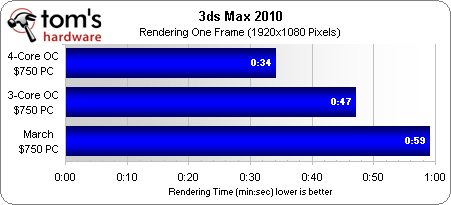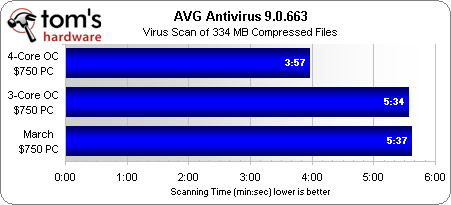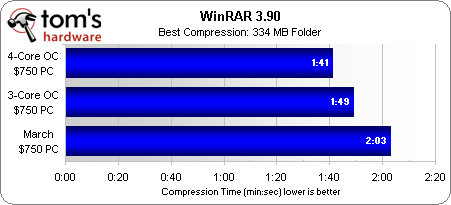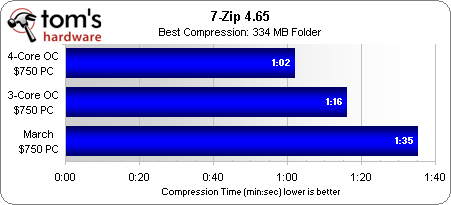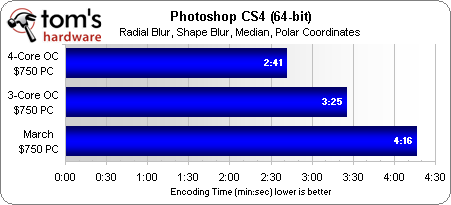System Builder Marathon, March 2010: $750 Gaming PC
Benchmark Results: Productivity
Overclocking alone yields a 26% reduction in rendering time in our new 2010 version of 3ds Max, but check out the massive 74% reduction once all four cores were enabled.
Forget overclocking, reducing scan times in AVG calls for additional processing cores. This is a new version of AVG, but our previous dual-core SBM systems usually took from 6.5 to seven minutes to scan these same compressed files.
WinRAR is a repeat benchmark, and the stock March PC finishes in the same exact time as the overclocked December SBM PC.
Going back to the last SBM, this is the sole application where swapping in DDR2-1066 provided a large performance impact, allowing the overclocked December PC to finish in 1:44, a whole 19 seconds faster than with DDR2-800 and just few seconds behind today’s unlocked quad.
The 7-Zip benchmark replaces WinZip and clearly shows benefits from both additional cores and overclocking.
Photoshop CS4 is another repeat benchmark version carried over from the previous SBM. The March SBM PC finishes the job 24 seconds faster than the December PC, but takes 15 seconds longer once both are overclocked. Erase the near loss though, as in the end having a stable fourth core propels the December PC back into the lead by nearly half a minute.
Current page: Benchmark Results: Productivity
Prev Page Benchmark Results: Audio And Video Encoding Next Page Power Consumption, Performance Summary, And EfficiencyGet Tom's Hardware's best news and in-depth reviews, straight to your inbox.
-
erdinger Good job. I Really like the system and I agree in nearly every decision.Reply
unlocking the forth core and still overclocking to 3.6Ghz is just great! I'm getting jealous because my 4th core is broken.
I'm looking forward to the value comparison. -
cruiseoveride This is almost identical to my build. But I used 2nd hand parts, dual HD4870s and it worked out just less than $600.Reply
4 cores, 3.2Ghz, 13,000 3dmark points.
Great bang-for-buck system. -
stray_gator Apart from a SBM entry, this article also provides reality check regarding the benefits of a fourth core. quite useful.Reply -
jsowoc I find the value comparisons are usually (always?) that the least expensive computer has the most "value", followed closely by the middle computer, trailed by the most expensive setup.Reply
Would it be possible to make a 3-way comparison of systems at the same price (for example, $1000)? One could be an AMD-based system, another an Intel-based, and a third maybe a graphics-heavy monster, or a MicroATX system (to see how much performance you sacrifice to stay in $1000 and fit a small form factor). -
Otus What would by interesting is a round of "upgrade" builds. Set specific budgets for ungrades and add them on top of the hardware from a previous round. That would allow commentary on upgrade paths and also help builders of new rigs.Reply -
Crashman jsowocI find the value comparisons are usually (always?) that the least expensive computer has the most "value", followed closely by the middle computer, trailed by the most expensive setup.Would it be possible to make a 3-way comparison of systems at the same price (for example, $1000)? One could be an AMD-based system, another an Intel-based, and a third maybe a graphics-heavy monster, or a MicroATX system (to see how much performance you sacrifice to stay in $1000 and fit a small form factor).Reply
Except for the CPU cooler, you usually sacrifice nothing to go Micro ATX. Tom's Hardware even did a micro-ATX SBM...where the Core i7 system sucked because it had to use the stock cooler. You can find semi-small micro-ATX cases that fit mid-sized coolers.
Antec also makes a MICRO ATX MID TOWER which REALLY sux since it misses the point of Micro ATX completely, so I don't want to hear about that one.
And of course there's Micro ATX mini-towers with the same layout as full-ATX. You get all the performance of ATX and the big cooler, with a case that's around 14-15" tall. -
jsowoc CrashmanExcept for the CPU cooler, you usually sacrifice nothing to go Micro ATX. Tom's Hardware even did a micro-ATX SBM...where the Core i7 system sucked because it had to use the stock cooler. (...)Reply
My argument was not that they should do a $500-$1000-$2000 comparison of uATX builds - they did this. I was suggesting doing a $1000intel - $1000amd - $1000uATX comparison. -
tigerwraith I still dont understand why they went with 2 gfx cards. Ive seen in a lot of reviews that even the newest games dont always work right off the bat when using Crossfire or SLi, So why not spend the money on a 5770 for this. You get DX 11, Dual to Triple moniters, and passthrough. So say you wanted to build a budget HTPC that could game Id have went with the 5770 or 5830 not only would that be a great cpu to watch on a HDTV but you would only need the HDMI cable to run everything.Reply

